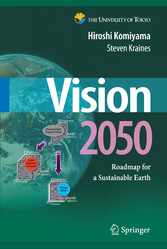Search and Find
Service
Preface
5
Contents
10
Is the Earth Sustainable?
12
1 Changes from Which the Earth Recovers, and Changes from Which the Earth Does Not The Continuous Renewal of the Circulating Earth
12
Changes from Which the Earth Does Not Recover
13
How Long Does It Take for Ice to Melt?
14
2 Mechanisms for Recovery Circulating Ecosystems Powered by the Sun
15
The Wind and Rain Also Are Caused by the Sun
16
The Amount of Elements in the Biosphere Is Constant
16
3 A Massive Intervention by Humanity into the Biosphere A Century of Expanding Human Activities
17
The Use of Fossil Fuel Resources
20
Diminishment of Nature and Accumulation of Human Artifacts
22
The Influence of Toxic Materials
22
4 The Flow of Materials Resulting from Making Things”
24
Accumulating Metals
25
The One-Way Flow of Cement and Glass
27
Petroleum Products Are Also a One-Way Flow
28
Biomass Materials Are Recirculated
29
Sustainable Lifecycles and Non-sustainable Lifecycles
31
5 What Happens if We Continue with Business as Usual”? Oil Reserves Will Become Depleted
32
Global Warming Will Alter the Earth’s Climate
33
The Earth Will Become Buried in Human Waste
35
Knowing Energy
37
1 Energy Is Conserved Energy Is the Ability to Do Work
37
Kinds of Energy
38
Energy Media and the Law of Energy Conservation
39
How a Thermal Power Plant Works
41
How Electric Cells Work
43
Energy Resources
44
Expressions for Energy
45
2 What Is Energy Used for? World Energy Consumption Is One Ton per Person per Year
47
Energy Use in Daily Life
47
The Production of Basic Materials Is the Core of Manufacturing
49
Energy Loss in the Energy Conversion Sector
50
3 Energy Degrades What Is the Value of Energy?
52
4 Improving Ef.ciency Burning Oil Fields Versus Heating Houses
55
The Limit of Energy Ef.ciency
58
1 The Elementary Steps of Human Activities
58
2 The Energy of Elementary Steps The Energy of Transportation Is Zero
59
Energy Is Needed for Separation
61
The Energy of Shaping and Forming Is Zero
62
Heating and Cooling Using an Ideal Air Conditioner
63
Do Compression and Expansion Slowly
64
Measuring Chemical Reactions Through an Ideal Electric Cell
64
The Theoretical Ef.ciencies of Energy Devices Are All the Same
66
Comparing the Energy Consumption of the Elementary Steps
66
3 The Energy of Human Activities
68
Energy Conservation in Daily Life
69
1 The Automobile
69
How Conventional Automobiles Work
70
High-Ef.ciency Engines and Hybrid Cars
71
Fuel-Cell-Powered Electric Cars
74
Lowering Vehicle Weight
75
The Future Form of Automobiles
76
2 Homes and Offices
78
How an Air Conditioner Works
78
Energy Conservation by Improving Air Conditioner Ef.ciency
80
Energy Conservation Through Load Reduction
82
It Is Wasteful to Use Gas to Boil Water
83
How Effective Is Cogeneration?
83
Reduce Energy Consumed for Heating and Cooling to One Tenth
85
Lighting
85
3 Power Plants
85
The High-Temperature Limit
86
Combined Cycle Electric Power Generation
87
Making Things and Recycling Things
89
1 The Theory of Recycling Human Artifacts Will Eventually Become Saturated in Society
89
2 Recycling That Is Also Energy Conservation
93
Reduction of Iron Ore: The Blast Furnace Method
94
Recycling of Iron: The Electric Arc Furnace Method
95
Electrolysis Versus Electric Melting of Aluminum
97
Recycling of Non-metal Mineral Materials
97
Recycling Is a Means for Energy Conservation
99
3 Is It Bad to Burn Waste Paper and Plastic? Even if We Burn Paper, It Can Still Be Recycled
100
Introduction of Renewable Energy
104
1 Could Intensi.cation of Nuclear Power Be the Answer?
104
Types of Nuclear Power
104
Concerns About Safety
105
2 Sunlight Sufficient Amount and Excellent Quality
106
The Maximum Power of a Solar Car Is Two Horsepowers
108
Biomass Is 5%
109
Methods for Solar Thermal Power Generation
110
Solar Cells Are 40%
112
Does Developing New Technologies Require Too Much Energy?
113
Comparing Solar Cells and Biomass
114
3 Hydropower and Wind Power Potentials Large and Small
115
4 Geothermal Energy and Tides
117
How to Make a Sustainable Earth
119
1 The Signi.cance of the Kyoto Protocol The Inevitability of Global Warming
119
A Gap Between the Developed World and the Developing World
120
Hope, but Do Not Expect Too Much . . .
122
2 Vision 2050: A New Road to a Sustainable Earth Three Preconditions
123
The Basic Concepts
124
A Crossroads
127
3 Making Vision 2050 a Reality
128
How Will Technology and Society Work Together?
141
1 Forming a Total Infrastructure for Circulating Materials in Society The Importance of Separation in Garbage Collection
141
A Minimum Amount of Waste Emissions
142
Product Design and Standardization
143
Choosing the Optimal Scale
144
A Network System for Biomass Collection
146
2 Making the Market Work for Sustainability Can We Leave Things to the Invisible Hand of the Free Market?
147
3 Projects for Vision 2050
150
Design of Giant, Complex Systems
151
A Large-Scale, High-Ef.ciency Manufacturing System for Solar Cells
152
Utilizing the Polar Regions and Outer Space
153
Designing the Komiyama House
154
4 Rebuilding the Relationship Between Technology and Society The Problem of Dioxins
155
Postscript
162
About the Authors
165
All prices incl. VAT













